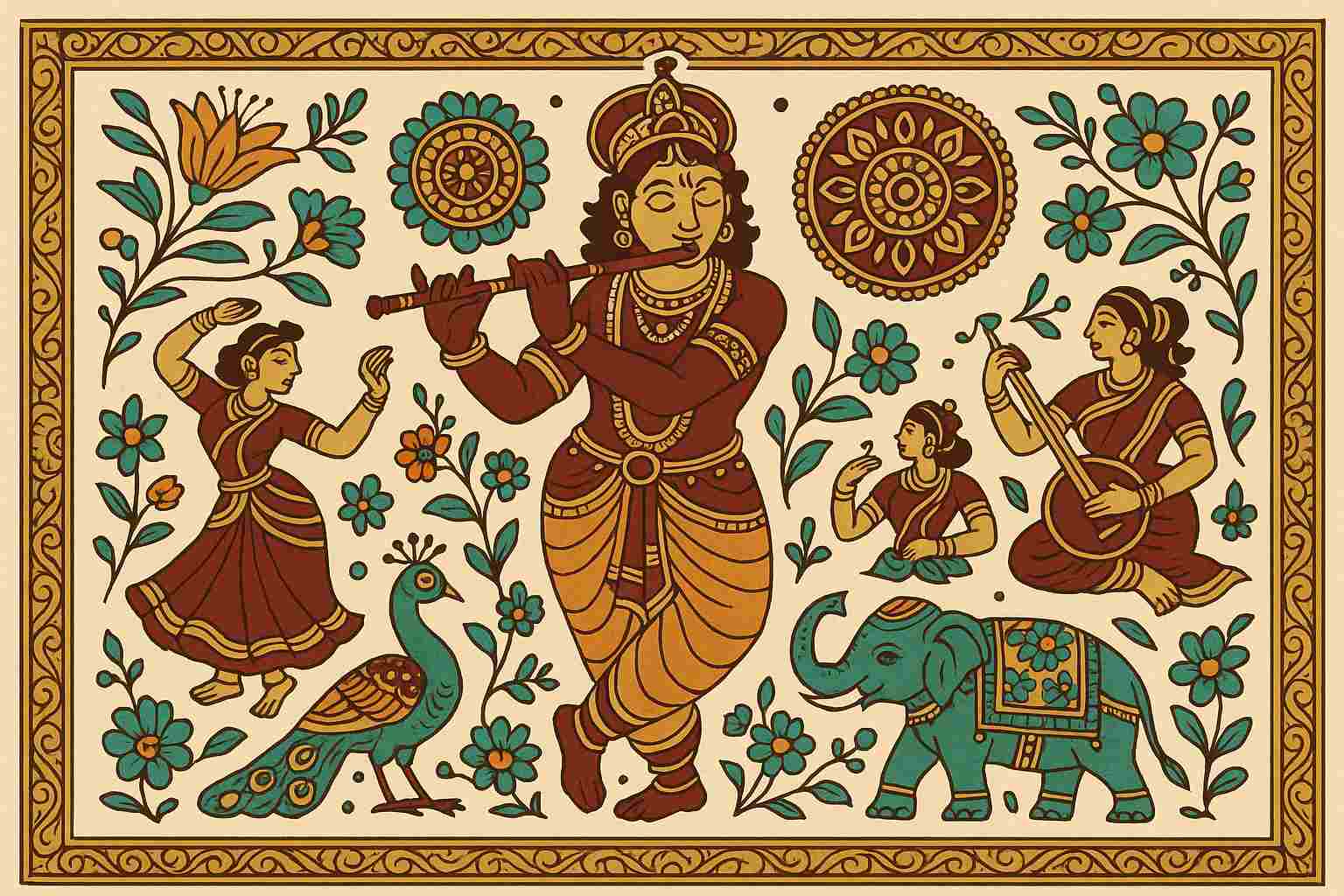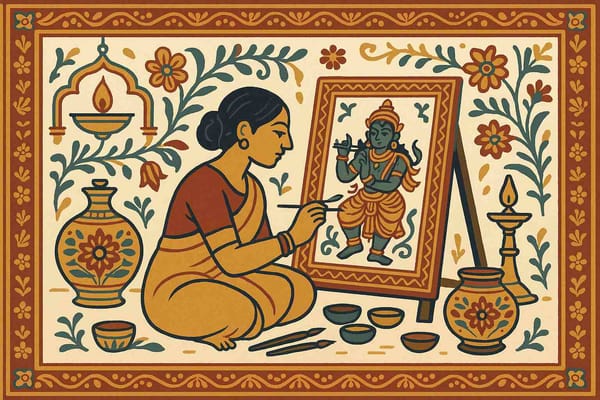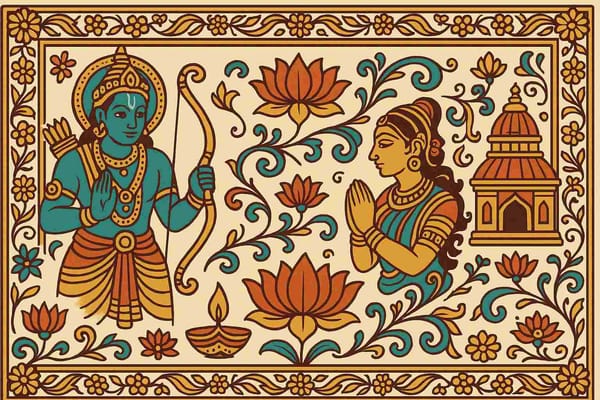
Pattachitra Art: Techniques and Traditions-A 2025 Exploration
Some stories aren't just told with words; they are painted with devotion, coloured with faith, and preserved on cloth for centuries. Imagine an art form so pure that its colours are borrowed from mother earth, its canvas is prepared with patient hands, and its every motif sings a tale of our gods. This is the living, breathing world of Pattachitra, a timeless tradition from the heartlands of Odisha and West Bengal.
It feels like more than just art, doesn't it? It’s a piece of our collective memory, a visual bhajan that connects us to our roots. Let's take a moment to sit with this beautiful heritage and understand the soul behind each masterpiece.
The Heart of Pattachitra: A Divine Narrative on Cloth
The name itself, "Pattachitra," comes from Sanskrit, where 'Patta' means cloth and 'Chitra' means picture. This isn't just any painting; it’s a form of storytelling that has flowed through generations since the 5th century BC. Traditionally, these scrolls were part of temple rituals, especially in the sacred premises of the Jagannath Temple in Puri. They narrate timeless epics—the divine leelas of Krishna, the courage of Rama, the ten avatars of Vishnu, and the fierce grace of Maa Durga.
Each painting is a prayer, a medium for the artist, or 'Chitrakar,' to connect with the divine. It's a tradition where faith guides the hand, and the result is nothing short of a spiritual experience captured on canvas.
Crafted by Hand, Blessed by Nature: The Sacred Process
The creation of a Pattachitra painting is a beautiful ritual in itself. It’s a slow, mindful process that honours nature and tradition at every step. There are no shortcuts here, only pure dedication.
- Preparing the Canvas (Patta): The journey begins with a fine piece of cotton cloth. This cloth is lovingly coated with a special paste made from crushed tamarind seeds and chalk powder, creating a durable, leathery surface. After drying in the sun, it is polished meticulously with a smooth stone or shell until it shines, ready to receive the sacred art.
- A Palette from Mother Earth: Pattachitra artists use only natural colours, prepared from scratch. White is derived from powdered conch shells, black from the soot of a burning wick, vibrant yellow from haritala stone, and rich red from the hingula stone. This connection to natural elements infuses the artwork with a unique, earthy vibrancy that synthetic colours can never replicate.
- The Divine Outline: With brushes made from the fine hair of squirrels or goats, the artist first draws the intricate outline. The figures are distinct, often shown in profile with elongated, graceful eyes. This framework is then filled with colour, followed by the addition of delicate patterns and ornate borders that frame the central story, making the entire piece feel complete and divine.
The Many Voices of Pattachitra: A Rich Tapestry of Styles
While rooted in the same spiritual soil, Pattachitra blossoms into different styles across regions, each with its own unique flavour and voice.
- The Temple Art of Odisha: This is perhaps the most iconic style, known for its deep connection to Lord Jagannath. The art is incredibly detailed and symmetrical, with strong, bold lines and a symbolic colour palette. You’ll often see themes of the Dashavatara and Krishna’s Raas Leela, framed by exquisite floral borders.
- The Story-Songs of Bengal: In West Bengal, Pattachitra is often accompanied by 'Pater Gaan'—songs sung by the artists themselves as they unroll the scroll to narrate the story painted on it. These paintings feature bold lines and not only cover mythological tales but also social issues and historical events, acting as a form of social commentary.
- The Whispers on Palm Leaves (Tala Pattachitra): A truly unique variation, this form is not painted but intricately carved onto dried palm leaves. Artists use a special needle-like tool to etch delicate lines, which are then filled with a paste of turmeric or charcoal to make the illustrations visible. These often depict local legends and deities.
Pattachitra in Our Modern Lives: A Heritage to Cherish
In villages like Raghurajpur in Odisha, this sacred art is a way of life, with skills passed down from one generation to the next. This dedication is a beautiful example of how ancestral traditions and rites keep our culture alive. Today, Pattachitra has gracefully moved from temple walls into our homes, adorning them with divine stories and vibrant energy. It reminds us of the profound connection between craftsmanship, culture, and spiritual expression.
However, the artists who are the custodians of this heritage face challenges from mass-produced prints. By choosing an authentic, handmade Pattachitra, we are not just buying a piece of art; we are honouring the artist's dedication, supporting their livelihood, and helping preserve a priceless piece of our culture.
Your Questions on This Divine Art Form, Answered
Many of us feel a deep curiosity when we look at a Pattachitra painting. What truly makes this art form so unique compared to others? It’s the beautiful mix of detailed storytelling, the use of colours straight from nature, and the intricate patterns that tell tales of our gods and heroes with such devotion.
You might also wonder how long it takes to bring one of these masterpieces to life. Given the meticulous, step-by-step process, a single detailed painting can take an artist weeks, or sometimes even months, to complete. This patience and dedication are what make each piece so special.
And yes, while the art is steeped in tradition, many artists are happy to create customised paintings. They can weave your preferred stories or deities into the classic Pattachitra style, making it a deeply personal piece of sacred art for your home. When looking to bring one home, it's always best to buy from the artisans directly or from trusted platforms that honour their hard work, ensuring you receive an authentic piece filled with blessings.
Embracing Pattachitra: A Timeless Tradition for Our Times
Pattachitra is far more than an art form—it is a cherished part of India's soul, carrying stories of faith and craftsmanship through the ages. By choosing authentic Pattachitra, we celebrate the hands that create it and ensure this divine tradition continues to inspire future generations. Let's welcome this timeless art into our lives and keep its sacred stories alive.
If these stories of art and devotion touch your heart, you'll find a home at Bhaktilipi. We are dedicated to preserving and sharing the timeless wisdom of our culture in a way that connects with you today. From understanding sacred rituals to exploring divine art forms like Pattachitra, we are here to enrich your spiritual journey.
Stay connected with our community and dive deeper into the ocean of devotional knowledge. Follow us on Facebook, Instagram, and YouTube for new articles, videos, and much more.
A passionate group of people dedicated to preserving India's knowledge of Dharma, Karma, and Bhakti for ourselves and the world 🙏.
Comments
Related in

Exploring Pattachitra- Tradition and Craft Define Art
There are some art forms that are more than just colours on a canvas; they are a prayer, a story, a living, breathing piece of our heritage. For me, Pattachitra is one such treasure. When you look at a Pattachitra painting, you're not just seeing an image; you&

Exploring Pattachitra- Art and Culture Define the Ancient Craft
Imagine holding a piece of cloth that breathes with stories from ages ago. A canvas where every line, every colour, sings a hymn in praise of the divine. This isn't just a painting; it's a living tradition, a form of devotion that has flowed through the

Pattachitra Techniques-Traditions-History-Explore Ancient Art
Have you ever felt the magic of a story so powerful it seems to come alive? Imagine that story, not just in words, but captured in a burst of brilliant colours on a simple scroll of cloth. That, my friends, is the heart and soul of Pattachitra. It’s more
